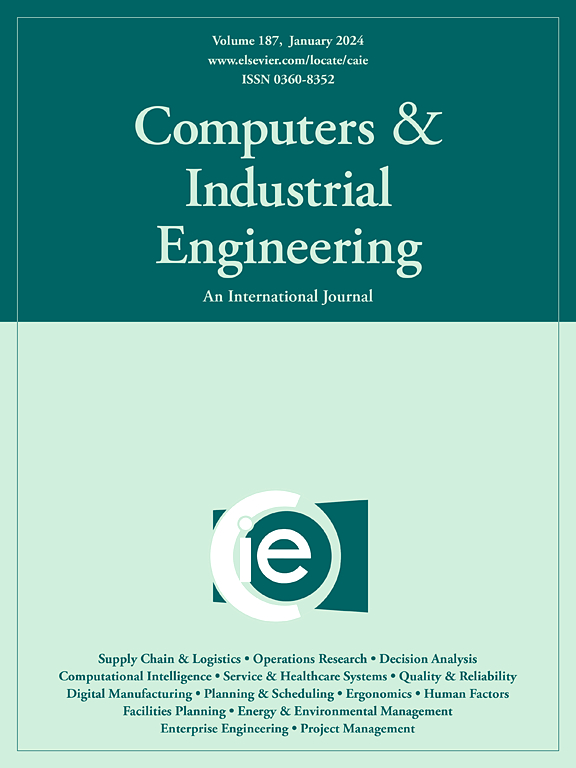Sustainable post-disaster humanitarian logistics network design: A real-case study with consecutive disaster risks
IF 6.5
1区 工程技术
Q1 COMPUTER SCIENCE, INTERDISCIPLINARY APPLICATIONS
引用次数: 0
Abstract
Humanitarian logistics involves managing assets, skills, and knowledge to provide emergency relief to vulnerable societies against disasters and emergencies. After disasters, it is essential to mobilize logistics resources to assist victims and transport humanitarian supplies. An efficient and sustainable aid response plan can decrease social, economic, and environmental impacts. This paper dwells on sustainable post-disaster humanitarian logistics (SPD-HL) with environmentally friendly and conventional vehicles. The problem aims to establish the routes, schedules, and charges of the heterogeneous fleet, which designs the distribution of multi-relief items to vulnerable people in emergency assembly points and temporary shelter areas spread out in a geographically dispersed area. The objective of the SPD-HL is to minimize the total time that covers total travel time, charging duration, and total earliness and lateness. To solve this new complicated problem variation, we developed a sophisticated metaheuristic that integrates an adaptive large neighborhood search (ALNS) with a problem-specific construction and local search procedures. We conducted extensive experimental analyses on new real-world data instances to examine the performance of the heuristic. According to computational results, the proposed method effectively yields high-quality solutions compared to CPLEX results in small-size instances and improves solution quality in large-size instances. Additionally, we conduct scenario analyses with an energy and social cost-based combined objective function and the probability of road closure cases due to consecutive disasters. The results can aid decision-makers in designing an efficient, sustainable emergency logistics network in the aftermath of disasters in a reasonable time to lessen the loss of human life, costs, and environmental impact.

可持续灾后人道主义物流网络设计:基于连续灾害风险的实际案例研究
人道主义后勤涉及管理资产、技能和知识,以便向易受灾害和紧急情况影响的社会提供紧急救济。灾害发生后,调动后勤资源援助灾民和运送人道主义物资至关重要。有效和可持续的援助响应计划可以减少社会、经济和环境影响。本文探讨了可持续的灾后人道主义物流(SPD-HL)与环境友好型和传统车辆。该问题旨在确定异构舰队的路线、时间表和收费,并设计将多种救济物品分配给分布在地理分散区域的应急集结点和临时避难所的弱势群体。SPD-HL的目标是最小化总时间,包括总行驶时间、充电时间和总早迟到时间。为了解决这种新的复杂问题变化,我们开发了一种复杂的元启发式算法,该算法将自适应大邻域搜索(ALNS)与特定问题的构造和局部搜索过程相结合。我们对新的真实世界数据实例进行了广泛的实验分析,以检查启发式的性能。计算结果表明,与CPLEX算法相比,该方法在小实例中有效地得到了高质量的解,在大实例中提高了解的质量。此外,我们使用基于能源和社会成本的联合目标函数和连续灾害导致道路封闭的概率进行情景分析。研究结果可以帮助决策者在灾害发生后合理时间内设计高效、可持续的应急物流网络,以减少人员生命损失、成本和环境影响。
本文章由计算机程序翻译,如有差异,请以英文原文为准。
求助全文
约1分钟内获得全文
求助全文
来源期刊

Computers & Industrial Engineering
工程技术-工程:工业
CiteScore
12.70
自引率
12.70%
发文量
794
审稿时长
10.6 months
期刊介绍:
Computers & Industrial Engineering (CAIE) is dedicated to researchers, educators, and practitioners in industrial engineering and related fields. Pioneering the integration of computers in research, education, and practice, industrial engineering has evolved to make computers and electronic communication integral to its domain. CAIE publishes original contributions focusing on the development of novel computerized methodologies to address industrial engineering problems. It also highlights the applications of these methodologies to issues within the broader industrial engineering and associated communities. The journal actively encourages submissions that push the boundaries of fundamental theories and concepts in industrial engineering techniques.
 求助内容:
求助内容: 应助结果提醒方式:
应助结果提醒方式:


